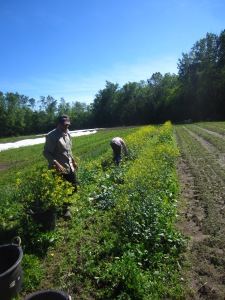I have dedicated my Wednesday blog to wild edibles, which is appropriate because we do most of our weeding on Wednesdays as well. It’s the only day of the week we aren’t harvesting and preparing for CSA boxes or markets. The days get filled up pretty quickly with tasks to do around the farm, and sometimes the weeding gets pushed to the back burner. At the beginning of the year we tried to stay on top of the weeds, addressing them when they are small so they couldn’t get established. We run the rows with claws and hoop hoes, and the idea is to disrupt the roots so the sun can kill them off. However, when five acres are under cultivation, and the weeds grow faster than the vegetables then it’s easy to have more of the unwanted green stuff than expected. At this point in the season, we aren’t using tools to remove the weeds, only our most valuable power tools; our hands. It takes more time to weed by hand, however I enjoy the satisfaction from yanking them out. It’s fun to throw them in a pile, and look back to see the progress I’ve made, like a Mr. Clean commercial.
The weed we are currently battling the most is Lambs Quarters. It is an annual wild edible that has spade shaped leaves with a mint green colour and looks dusty. This is due to a white powdery coating on the leaves, which easily rubs off with your fingers. Lambs Quarters is also known as wild spinach and is packed with nutrients and minerals, and included in the quinoa family, giving it plenty of antioxidants as well. The plant is not only healthy for human consumption, but for the soil it grows in. It is a purifying plants and helps to restore healthy nutrients to the dirt if need be. It brings up the nutrients from deep in the soil from its roots, which helps other surrounding plants to grow. This means that lambs quarters can be considered a companion plant, if the quantity is kept under control.
It is extremely important to keep Lambs Quarters at bay, and avoid the plant going to flower and seed. The reason being that each plant can produce up to 75,000 seeds, which means, you’ll never rid your garden of the plant. The stems of the plant are branched, the leaves are goose foot shaped, with some teeth along the edges and the flowers are tiny whitish green. It can be found pretty much anywhere soil is disturbed.
The parts of the plants that can be consumed are the leaves, shoots, seeds, and flowers. The seeds turn black in the fall, and are healthy to eat, but difficult to extract, similar to quinoa. Lamb’s quarters contains oxalic acid, and should be eaten raw in small quantities, until the digestive system is used to it. However, cooking the plant removes the oxalic acid. Great ways to prepare this wild edible is steaming, soups, salads, smoothies or sautéed. To preserve this plant for the winter, you can blanch and freeze it or dry it.
Lambs quarters is the second highest wild edible in minerals and nutrients (after amaranth) and contains vitamins A, and C, B1, B2, B3, B6, calcium, magnesium, sodium, iron, zinc, manganese, selenium, potassium and phosphorus. In addition it is a good source of omega -3 and -6 fatty acids and also fibre and protein. This miraculous plant is not only good for humans and soil, but also for chickens and will result in dark yoked eggs and tender meat, and has also been grown for pig and sheep food.
Similar to quinoa, which is considered the food of the Mayan gods because of its power packed properties, lambs quarters has a great reputation around the world and throughout history. This plant can be found in all conditions from spring to fall and even grows in the Andes at a height of 3660 metres and has become an important substitute for rye and barely. This hardy plant has been found in archeological digging since the new Stone Age.
Lambs quarters is a wild edible that everyone should know about and consume. It’s easy to find, tastes great and grows in abundance. So help out your neighbour and pull some weeds out of their flower bed for them, and enjoy for dinner!


